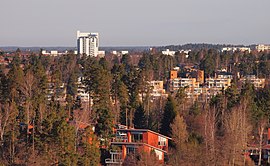Helsinki region
Helsinki Region ( Finnish Helsingin seutu , Swedish Helsingforsregionen ) and Capital Region ( Finnish Pääkaupunkiseutu , Swedish Huvudstadsregionen ) are names for the metropolitan area in and around the Finnish capital Helsinki . The region lies in the Uusimaa landscape on the Gulf of Finland , which is part of the Baltic Sea .
The two regional terms are defined by clearly formulated boundaries. They serve as administrative units and as a statistical unit, but are also used in everyday language.
Capital region (Pääkaupunkiseutu / Huvudstadsregionen)
The capital region includes the cities of Helsinki , Espoo , Vantaa and Kauniainen . Around 1.1 million people live in it and it is an important metropolitan area with 8,000 to 10,000 new residents moving into it every year. The region has an area of 765 km². This corresponds to only 0.2% of the area of Finland; However, around a fifth of all inhabitants of the country live on this. The population density is quite low for Northern European standards, but very high for Finland. There are still plenty of green spaces outside the city centers; these are repeatedly interspersed with high-rise or single-family housing estates, industrial and office complexes and spacious traffic routes.
The capital region is Finland's largest urbanized area and is the country's economic, cultural and scientific center. Eight of Finland’s twenty universities and the main offices of most large companies are in the region, as is the country’s main airport, Helsinki-Vantaa .
The central administrative authority in the capital region is the regional association Pääkaupunkiseudun yhteistyövaltuuskunta (YTV), which among other things, the waste management and regional passenger care. There are estimates that the region's growth will stagnate around the year 2030 at around 1.2 million inhabitants. The four cities actually form a large metropolis , but all four are independent cities.
Helsinki Region (Helsingin seutu / Helsingforsregionen)
The capital region, together with the neighboring municipalities of Hyvinkää , Mäntsälä , Pornainen , Järvenpää , Kerava , Kirkkonummi , Nurmijärvi , Sipoo , Tuusula and Vihti, make up the Helsinki region . Since these communities are all close to the capital region, professional and everyday life takes place beyond the community boundaries. These congregations are not members of the YTV regional association, but Kerava and Kirkkonummi will join it in the near future.
The Helsinki region has almost 1.4 million inhabitants today, and according to calculations it will be 1.5 million in 2025. In 1975 the population was 904,670. Around 21% of the inhabitants of the Helsinki region live in the suburbs outside the capital region. The annual population growth is 1.3%.
The centers of the region are connected to each other and to the capital by local rail transport in the Helsinki region and an efficient regional bus network.
Further names for the Helsinki region are Greater Helsinki or Helsinki Metropolitan Area .

